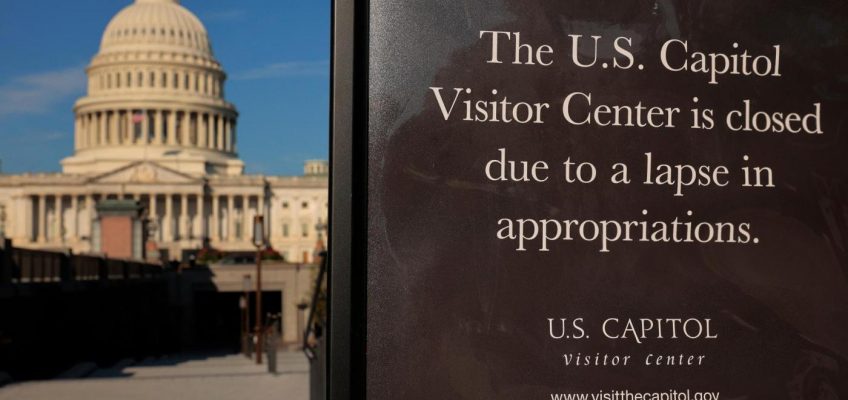By Nina Heller, CQ-Roll Call
WASHINGTON — When Alana Abbott showed up to the Capitol on Monday morning, she thought she’d at least be able to go inside and look at the gift shop and take a tour.
Related Articles
AI will soon have a say in approving or denying Medicare treatments
Florida farmers struggle as legal foreign workers worry about immigration crackdown
Watch live: Bondi defends herself against Democratic criticism that she’s weaponized the Justice Department
At the center of shutdown fight, health care is one of the most intractable issues in Congress
Canadian PM Carney visits Trump as relations between the longtime allies sit at a low point
But for her and others traveling to Washington, D.C., over the past few days, the government shutdown has made that impossible. Tourists are instead greeted by a sign saying the visitor center is closed due to a lapse in appropriations, along with a Capitol Police officer reinforcing that message.
Abbott came from Georgia with her mom and her son and had been planning their trip for three months. As members of Congress clash over how to fund the government for the fiscal year that began Oct. 1, visitors like them are caught in the middle.
“It’s just kind of disappointing,” she said.
Her family has been staying busy going to the Smithsonian museums, which are still open — for now. The Smithsonian announced last week that its museums and the National Zoo have enough unspent funds from the prior fiscal year to remain open through Oct. 11.
Abbott and her mom are both teachers, and were looking forward to telling their classes about the trip. “We knew a lot of things were going to be closed, but you’re hopeful something stayed open. But it does stink,” she said.
While the hallways are typically filled with people of all ages visiting from all over the world, the Capitol now resembles less a tourist attraction than a ghost town, save for the remaining members, congressional staff and journalists walking around. The Capitol Visitor Center, where tourists line up for tours led by red-coated guides, is a shell of its normally bustling self. And in the Rotunda, usually filled with visitors gazing up at George Washington floating above them in Constantino Brumidi’s famous fresco, it’s more of the same.
Emily Farnsworth and her family knew a shutdown could affect their trip from Utah, but they decided to come anyway and do what they could. So far, that’s meant visiting the United States Holocaust Memorial Museum, she said. But it’s also meant a canceled White House tour, too.
“It’s pretty frustrating. It’s like, what are the odds? I’m pretty bummed,” she said.
When the government partially shut down from late December 2018 into January 2019, tours of the Capitol were still running without disruption because the Legislative Branch Appropriations bill had already been passed and signed into law. But without that funding in place this time around, the shutdown has left tourists looking in from the outside.
“This is our nation’s capital and we can’t even go in and see all of the stuff that our nation stands for, unfortunately,” said her mom, Miley Farnsworth.
While staff-led and guide-led tours are currently on pause, members of Congress can still give tours themselves — which is what happened to a group of eighth-graders visiting Rep. Alexandria Ocasio-Cortez’s office.
“The organizers let them know that they weren’t able to get into the Capitol because the Capitol tours were canceled, [and] the congresswoman was like, ‘Oh, I’ll escort them myself,’” said Karla Santillan, spokesperson for the New York Democrat.
Not every part of the Capitol is off limits. Visitors with gallery passes, obtained from the offices of senators and representatives, will still be able to watch action unfold on the Senate or House floor. And constituents can still make their case to their elected representatives by entering the office buildings that ring the Capitol itself.
But the shuttered Capitol Visitor Center is the main entry point for tourists, funneling them through a security screening and a short film about the history of Congress and representative democracy. The U.S. Botanic Garden and the Library of Congress, two popular attractions on the Capitol campus, are also closed to the public.
According to the Architect of the Capitol, 60 percent of the building’s visitors come between March and July. Speaker Mike Johnson told reporters last week that around 7,000 people visit the Capitol every day. But for now, it will continue to be a series of locked landmarks and empty halls until the government is back open.
“For people who are passionate about government stuff, it is unfortunate that they don’t have some of the things manned, that people can still come. You spend a lot of money and people are planning trips here and visitor centers are not open, so it is frustrating,” Miley Farnsworth said.
©2025 CQ-Roll Call, Inc., All Rights Reserved. Visit cqrollcall.com. Distributed by Tribune Content Agency, LLC.




